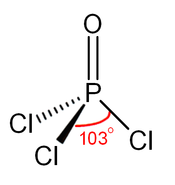Phosphorus oxychloride
Agent Name
Phosphorus oxychloride
CAS Number
10025-87-3
Formula
Cl3-O-P
Major Category
Toxic Gases & Vapors

Synonyms
Fosforoxychlorid [Czech]; Oxychlorid fosforecny [Czech]; Phosphoric trichloride; Phosphoroxychloride; Phosphorus chloride oxide (POCl3); Phosphorus oxide trichloride; Phosphorus oxychloride; Phosphorus oxytrichloride; Phosphoryl chloride; Phosphoryl trichloride; Trichlorophosphine oxide; Trichlorophosphorus oxide; [ChemIDplus] UN1810
Category
Acid Halides
Description
Clear, colorless to yellow, oily liquid with a pungent & musty odor. [Note: A solid below 34 degrees F.]; [NIOSH]
Sources/Uses
Used in chemical synthesis as a chlorinating agent and catalyst and to produce plasticizers, hydraulic fluids, gasoline additives, and fire retardants; [ACGIH]
Comments
Liquid causes second or third degree burns after short contact; [CHRIS] Highly corrosive to skin; [Quick CPC] Mucous membrane irritation, bronchitis, pulmonary edema, and nephritis have been reported after occupational exposure. [ACGIH] Liver injury in animals in a chronic study; [Desai, H. Phosphorus and Phosphorus Compounds. In: Sullivan J, Krieger G (eds). Hazardous Materials Toxicology. Baltimore:Williams & Wilkins,1992;939] A corrosive substance that can cause pulmonary edema; [ICSC] A lachrymator; [CHEMINFO]
Biomedical References
Exposure Assessment
Skin Designation (ACGIH)
Insufficient data
TIH
Yes
TLV (ACGIH)
0.1 ppm
Dangerous When Wet
Yes
MAK
0.02 ppm
Lethal Concentration
LC50 (rat) = 32 ppm/4h
Explanatory Notes
VP = 40 mmHg @ 81 deg F; [Sax] Some “Water Reactive Materials” are also TIH materials themselves: Phosphorus oxychloride; [ERG 2016]
Reference Link #2
NFPA
will not burn
Adverse Effects
Lachrymator
Yes
Toxic Pneumonitis
Yes
Hepatotoxin
Hepatoxic (a) from occupational exposure (secondary effect) or (b) in animal studies or in humans after ingestion
Nephrotoxin
Yes
Dermatotoxin
Skin burns
Diseases, Processes, and Activities Linked to This Agent
Diseases
Occupational diseases associated with exposure to this agent:
Processes
Industrial Processes with risk of exposure: